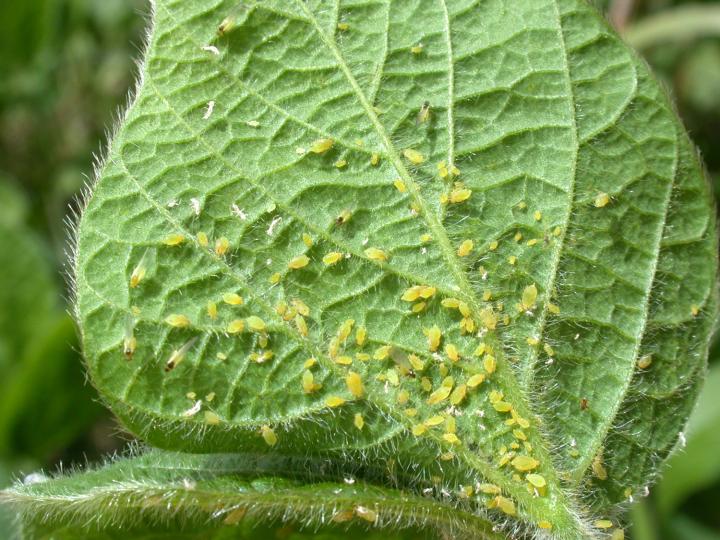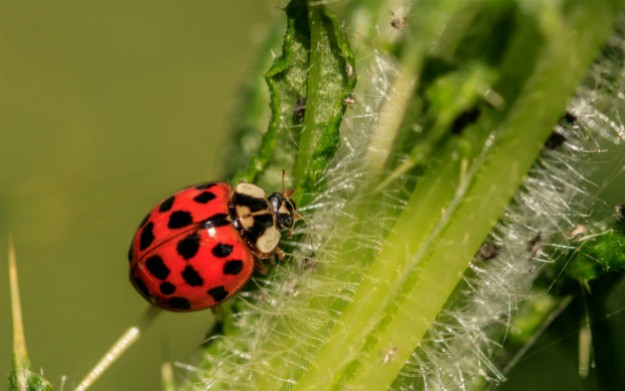Want to learn how to rid your garden on aphids? If those loathsome pests are ruining your beautiful garden, you better start acting on it. Here are some great ideas to help you out!
Learn How To Rid Your Garden of Aphids
When Aphids Attack: What Caused Them And What You Can Do
For those that have spent countless hours gardening, lovingly tending to plants, the arrival of aphids in the spring and summer can be a dreaded time. Just as your plants are beginning to enter their period of largest growth you may notice symptoms of an infestation.
This can include yellow, wilting leaves and shoots; large amounts of ants crawling around your plant; and a black, sooty mold growing on leaves and flowers. These are just some of the destructive effects that aphids have upon domestic plants. This can to a lot of headaches for farmers, gardeners, and anyone else who spends their time caring for delicate plants.
What causes these infestations? And what, if anything, can be done about them?
What are Aphids?
Aphids are not a single species; actually, they are a family of insects that represent over 4,000 different species . Biologists consider them to be some of the most successful animals on the planet. This is largely due to the fact that they’ve spread across the entire world and reproduce in absolutely staggering numbers.
The reason that so many different species of aphid exist is because individual species have adapted to only attack one type of plant. Some examples include the black bean aphid, the Russian wheat aphid, the wooly apple aphid and the wooly beech aphid. Each one of these is a highly adapted species of insect that preys on the sap or leaves of a particular plant.
Aphids, though found throughout the world, tend to prefer more temperate climates. While many parasitic insects are most numerous in tropical zones, aphids survive best in more mild climates. This is why they’re so common in the United States where the weather doesn’t get quite so hot as the rainforests.
You’ll want to be diligent in checking your plants for an aphid population. Especially once the weather warms up, it will be important to inspect your plants very thoroughly and regularly. Check them at least twice a week! You’ll need to check underneath the bottom of the leaves, as well as the stems, branches, and inside any crevices where small parasites can hide.
Identifying Aphids
Identifying aphids can provide a bit of a challenge to the novice gardener largely due to the fact that they’re so small. The size range of these insects runs from only about 1/16 to 3/8 of an inch.
Nymphs, or juvenile aphids, are even smaller than the adults. The vast majority of aphids are green in color, although some may be white or black as well. They have pear-shaped bodies and two black compound eyes; some species also have wings that are longer than the body itself.
Signs of Aphids
You needn’t necessarily locate the insects themselves to determine whether or not your plant has become infested. There will be other clues.

Yellowing leaves or black fungus developing on branches and flowers are tell-tale signs. Another strong indicator is the presence of a large population of ants crawling all over your plant. Certain ant species have a symbiotic relationship with aphids; the ants provide the aphids with protection from predators while harvesting the honeydew – a sticky, sugary liquid – that aphids produce.
Because the ants protect the aphids, controlling the ant population in your area is the logical first step in controlling the aphids. It’s important to take matters into your own hands as quickly as possible; once you start seeing the outward signs of an infestation, such as wilting, yellowed leaves, the population has already become that much harder to control.
Aphids usually feed by sucking a sap out of plants although others feed upon leaves or burrow into the soil and feed upon roots. It’s this method of feeding that’s what causes them to be such nasty pests; not only can they transmit deadly viruses to plants this way, they can damage leaves and roots directly, depositing a sticky liquid called honeydew all over the plant. The honeydew attracts ants, as well as wasps and is extremely conducive to the growth of black sooty mold. This mold isn’t particularly dangerous to the plant but can be extremely unsightly and ruin the appeal of decorative plants such as azaleas and laurels.
How Outbreaks Begin
As mentioned previously, aphids tend to show up in force around spring and summer time. They have a unique, complicated way of reproducing that is, at times, both sexual and asexual. During spring and summer, when food is plentiful, female aphids give live birth to female aphid nymphs, which are exact clones of their mother and grow up to give live birth to their own nymphs.
One generation of aphids only lives about 20-40 days so one summer can see dozens of generations come and go. When the weather cools, the food supply diminishes, and the days shorten, the female aphids will begin giving birth to male aphids as well. The males are often wingless and may even lack working mouth parts, but they are able to mate with the females which then lay eggs around leaves and inside of bark crevices. These eggs will remain over winter and hatch again in the spring, starting the process anew.
Particularly mild climates may skip this step entirely; if the weather’s good all year round then the females may simply continue spawning nymphs without any sort of break.
Because they reproduce so effectively and because of their great potential for destruction, any plant owner will need to take steps to curtail the population of aphids before any serious damage is done.
Did you know pouring a little beer in your garden can ward off slugs? More hacks here https://t.co/Jskpi41Soj pic.twitter.com/mcXEeTW4zX
— Homesteading (@HomesteadingUSA) March 8, 2016
There are several effective methods to do this
Method 1: Control the Ants
We’ve already mentioned controlling the ant population but this is key since they share a symbiotic relationship – one affects the other. Since ants and aphids are friends, removing the ants removes the bodyguards for aphids, leaving them open to predators.
One of the most effective (and beautiful) predators of the aphid is the ladybug. You can buy ladybugs in bags by the hundreds in your local gardening shop. You’ll need many of them, because this method requires a lot – and we do mean a lot – of ladybugs to truly affect the aphid population.

You’ll need to purchase your ladybugs and then refrigerate them during the day. Only at dusk should you release them onto your plant. If you release them during the bright sunlight hours, they won’t stick around; they’ll simply fly away immediately. So once it starts to darken you’ll want to release your ladybugs all across your plants. You may have to do this multiple times over several weeks, because as you can imagine, ladybugs won’t necessarily just stick around. They’ll fly off, never to return, leaving your only recourse to purchase more.
Check our sister site, DIY Ready's post on “DIY Ant Killer | 5 Ant Killer Recipes You Can Make at Home” and learn how to get rid of Ants.
Method 2: Soaps & Oils
Other natural methods of controlling aphids include making a homemade aphid soap full of vegetable oils (or canola oil) as it will suffocate aphids. Add a little bit of that to a spray bottle with some water and dish soap and spray your plant thoroughly. Leave the solution on for about two hours and then spray it off with your garden hose, blasting away any surviving parasites. As long as you are diligent about inspecting and protecting your plants, you should be able to keep aphid infestations at bay!
Check our post on “23 Different Ways To Make Soap from Home” and learn how to make a soap.
Method 3: Contact an Arborist
Of course, if you need additional help or guidance, you can call an arborist. They’ll be able to walk you through the process and what steps to take. It may require some landscaping, but you’ll get rid of these insects in no time.
Need more tips? Watch this video from GrowOrganic Peaceful Valley to see how to get rid of Aphids:
Thanks for checking our Learn How To Rid Your Garden of Aphids post! Which method of getting rid of Aphids will you try? Let us know in the comments below.
Follow us on instagram, twitter, pinterest, and facebook!
Like this? Then, you can't miss the links below:
How To Get Rid of Roaches At Home
How to Make a Simple Homemade Mosquito Trap With Cut Bottles
The Essential Benefits Of Worm Farming | Homesteading For Beginners
Author Bio : Aaron Sanders has worked in landscaping for 15 years and continues to be an asset to Mr. Tree Services. He firmly believes that your attitude determines your altitude in life.


[…] 20. Getting Rid of Aphids […]